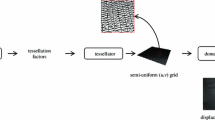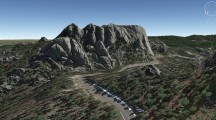Abstract
This paper presents an efficient way to render large-scale vector maps on level-of-detail (LOD)digital elevation models (DEMs). By using the frame buffer and Voronoi diagram, we achieve a rapid simplification of large-scale vector maps while keeping their original topological relationships. With the simplified maps, we establish level-of-detail vector map models. In the detailed level, we use the stencil shadow volume approach to render the map accurately, and in the coarse level we use substitute techniques to render the map approximately yet more quickly. The method proposed in this paper is universally applicable to rendering vector maps on various LOD terrain models, and the overlaying performance is independent of the complexity of underlying terrain surfaces. By use of the view frustum culling and sub-region index techniques, the impact of complexity of vector maps is reduced, and the rendering time is restricted to a certain scope. Thereby, we can achieve seamless and rapid rendering of large-scale vector maps on LOD terrain surfaces.
Similar content being viewed by others
References
ouglas D H, Peucker T K. Algorithms for the reduction of the number of points required to represent a digitized line or its caricature. Canad Cartograph, 1973, 10: 112–122
Estkowsk R, Mitchell J S B. Simplifying a polygonal subdivision while keeping it simple. In: Proceedings of 17th ACM Symposium on Computational Geometry. Medford, USA, 2001. 40–49
Mustafa N, Krishnan N S, Varadhan G, et al. Dynamic simplification and visualization of large maps. Int J Geograph Inf Sci, 2006, 20: 273–320
Mantler A, Snoeyink J. Safe sets for line simplification. In: Abstracts of 10th Annual Fall Workshop on Computational Geometry, New York, USA, 2000
Schneider M, Klein R. Efficient and accurate rendering of vector data on virtual landscapes. J Comput Graph Visual Comput Vision, 2007, 15: 59–66
Schneider M, Guthe M, Klein R. Real-time rendering of complex vector data on 3d terrain models. In: Proceedings of the 11th International Conference on Virtual Systems and Multimedia, Ghent, Belgium, 2005. 573–582
Wartell Z, Kang E, Wasilewski T, et al. Rendering vector data over global multiresolution 3d terrain. In: Proceedings on the Symposium on Data Visualization, Grenoble, France, 2003. 213–222
Wahl R, Massing M, Degener P, et al. Scalable compression of textured terrain data. J Comput Graph Visual Comput Vision 2004, 12: 521–528
Crow F. Shadow algorithms for computer graphics. In: Proceedings of the 4th Annual Conference on Computer Graphics and Interactive Techniques, California, USA, 1977. 242–248
Zhan H S, Li G X. Progressive transmission of vector map data based on polygonal chain simplification. Lecture Notes Comput Sci, 2006, 4282: 908–917
Sýkora D, Jelínek J. Efficient View Frustum Culling. http://www.cescg.org/CESCG-2002/DSykoraJJelinek/index.html, 2002
Morley M. Frustum Culling in OpenGL. http://www.cg.tuwien.ac.at/studentwork/CESCG/CESCG-2002/DSykoraJ-Jelinek, 2000
Roettger S, Heidrich W, Slusallek P, et al. Real-time generation of continuous levels of detail for height fields. In: Proceedings of International Conference in Central Europe on Computer Graphics, Visualization and Computer Vision, Plzen, Czech Republic, 1998. 315–322
Mcnally S. Binary Triangle Trees and Terrain Tessellation. http://www.longbowdigitalarts.com/McNally/progbintri.html, 2000
Author information
Authors and Affiliations
Corresponding author
Rights and permissions
About this article
Cite this article
Yang, L., Zhang, L., Kang, Z. et al. An efficient rendering method for large vector data on large terrain models. Sci. China Inf. Sci. 53, 1122–1129 (2010). https://doi.org/10.1007/s11432-010-0091-z
Received:
Accepted:
Published:
Issue Date:
DOI: https://doi.org/10.1007/s11432-010-0091-z




